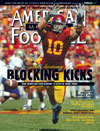AMERICAN FOOTBALL MONTHLY THE #1 RESOURCE FOR FOOTBALL COACHES
Article CategoriesAFM Magazine
|
Stifling the Screen PassThere are other things than pursuit & hustle that add to stopping the screen passby: Mike Kuchar © More from this issue Why do offenses run the screen pass? Very simple – it’s a high risk, high reward play. It’s an easy completion percentage for the QB and if the timing is right and the play gels, it could be potentially devastating to the defense. The high percentage of the throw builds confidence for your QB and gets him through a tough set of downs. Plus, the screen play gets the ball into your playmakers’ best hands and gives them plenty of room to run. Just a few months back in the April issue of AFM, Phil Longo, the offensive coordinator at Southern Illinois University, promoted the bubble screen because of its high efficiency rate. “The numbers advantages that we created when defenses loaded eight, and sometimes nine, defenders in the box to stop the run are no longer as readily available when you start to go to the screen game,” Longo s....The full article can only be seen by subscribers. Subscribe today!
|
|
|||||||
| HOME |
MAGAZINE |
SUBSCRIBE | ONLINE COLUMNISTS | COACHING VIDEOS |
Copyright 2025, AmericanFootballMonthly.com
All Rights Reserved





